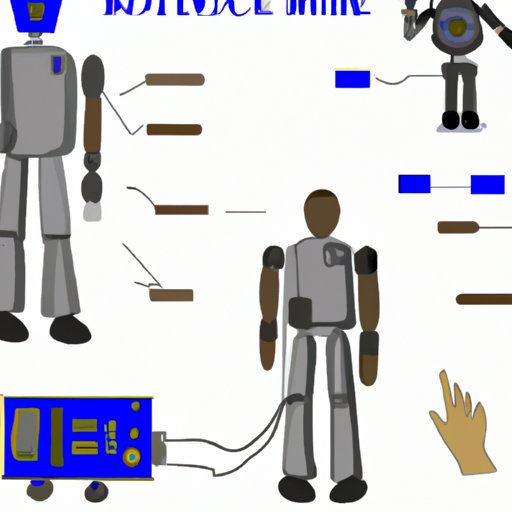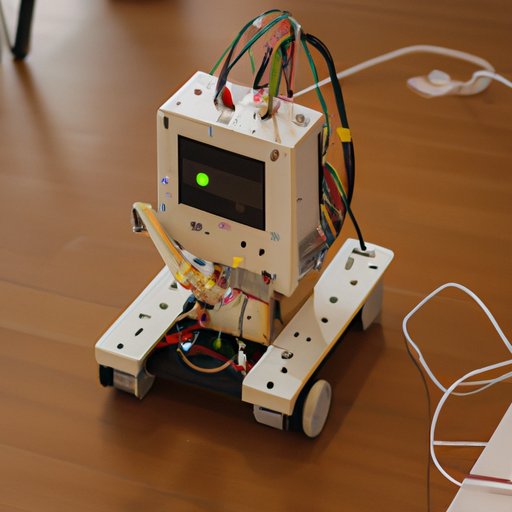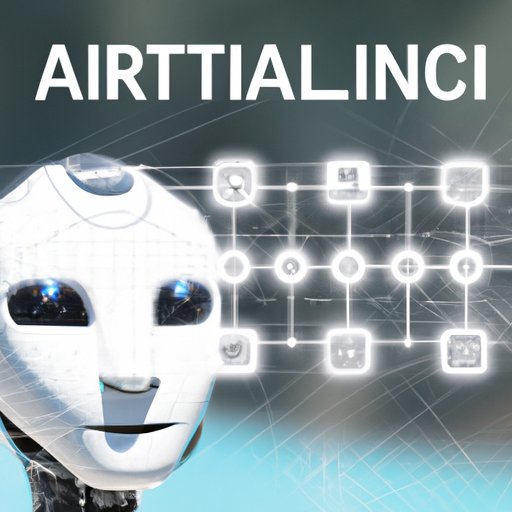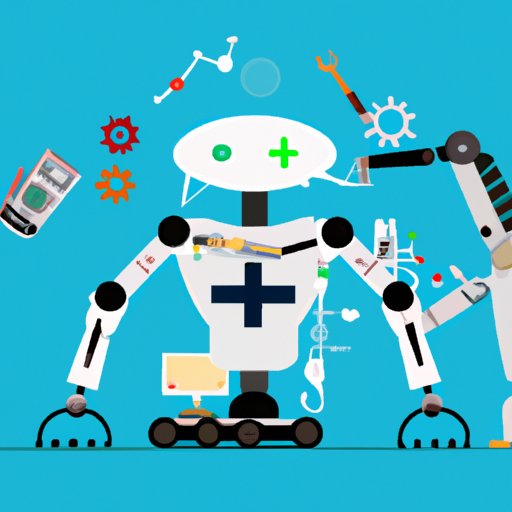Introduction
Robotics is a rapidly evolving field that has revolutionized many industries and changed the way humans interact with technology. A robot is a machine or device that can be programmed to perform a variety of tasks autonomously or semi-autonomously, without direct human intervention. In simple terms, robots are automated machines that can think for themselves and act on their own. They can be used in a variety of settings, from manufacturing plants to medical facilities, entertainment venues, and even homes.
Overview of the History and Evolution of Robots
The concept of robots dates back centuries, to ancient myths and legends. The modern notion of robots was first popularized in the 1920s by Czech playwright Karel Čapek, who wrote a play called R.U.R (Rossum’s Universal Robots). Čapek’s play introduced the term “robot” to the world, and it has been in use ever since. The first robots were created in the late 1940s and early 1950s, when researchers at MIT developed the first programmable machines. Since then, robots have evolved to become more sophisticated and capable of performing ever more complex tasks.

Types and Applications of Robots
Robots come in all shapes and sizes, and they can be used for a wide range of applications. The most common types of robots include industrial robots, service robots, medical robots, and entertainment robots.
Industrial Robots
Industrial robots are typically used in manufacturing, assembly, and other industrial processes. They are designed to automate repetitive tasks, such as welding, painting, and packaging. Industrial robots are usually large and expensive, but they can significantly reduce production costs and improve efficiency.
Service Robots
Service robots are designed to assist humans in everyday tasks. These robots are often used in retail stores, restaurants, hotels, and airports. They can also be used at home, where they can be programmed to vacuum, mow the lawn, or perform other household chores. Some service robots are even equipped with artificial intelligence, allowing them to interact with humans in a more natural way.
Medical Robots
Medical robots are used in hospitals and other healthcare facilities to help doctors and nurses with patient care. They can be used for surgical procedures, drug delivery, and other medical tasks. Medical robots are becoming increasingly advanced, with some models even able to make decisions independently.
Entertainment Robots
Entertainment robots are used mainly for recreational purposes. They can be programmed to dance, play music, or even provide companionship. Entertainment robots are becoming increasingly popular, with companies like Sony and Hasbro releasing their own models.
Benefits of Robotics
Robots offer a number of advantages over traditional methods of production and labor. Here are just a few of the benefits of robotics:
Increased Efficiency
Robots can work faster and more accurately than humans, which can lead to increased efficiency in production and labor. This can result in cost savings and improved quality of products and services.
Cost Savings
Robots require less maintenance and less energy than humans, which can result in significant cost savings. Additionally, robots can be programmed to operate 24 hours a day, seven days a week, resulting in further cost savings.
Improved Quality
Robots are programmed to perform tasks with precision and accuracy, resulting in improved quality of products and services. Additionally, robots can be programmed to detect defects in products, ensuring that only high-quality items reach the customer.
Ethical Considerations of Robot Use
Despite the many advantages of robotics, there are still ethical considerations to keep in mind when using robots. Here are a few of the ethical issues that need to be considered:
Safety
Robots can be dangerous if they are not properly programmed or maintained, so safety must be a top priority. It is important to ensure that robots are programmed to follow safety protocols and that they are regularly inspected and maintained.
Privacy
Robots can collect sensitive data about people, which raises privacy concerns. It is important to ensure that robots are programmed to protect the privacy of individuals and that any data collected is treated responsibly.
Unintended Consequences
Robots can have unintended consequences, such as job loss or environmental harm. It is important to consider the potential impacts of robot use before implementing them.

Programming a Robot: How It Works
Before a robot can be put to use, it must be programmed. Programming a robot involves writing code that tells the robot how to move, what to do, and how to respond to different situations. Here is an overview of the process:
Overview of the Process
Programming a robot involves writing code in a programming language, such as C++ or Java. This code is then uploaded to the robot’s hardware, which consists of sensors, motors, and other components. The code tells the robot how to interpret the data from its sensors and how to act on that data. Once the code is uploaded, the robot is ready to go.
Programming Languages
Robots can be programmed in a variety of programming languages, such as C++, Java, Python, and Lisp. Each language has its own syntax and rules, so it is important to choose the right language for the task at hand.
Hardware Requirements
In addition to programming, robots also require certain hardware components, such as sensors, motors, and actuators. Depending on the type of robot, the hardware requirements may vary. For example, an industrial robot may require more powerful motors than a service robot.

Artificial Intelligence and Its Role in Robotics
Artificial intelligence (AI) is a branch of computer science that deals with creating computers that can think and act like humans. AI has become increasingly important in the field of robotics, as robots are now being equipped with AI technology to enable them to think and act more like humans. Here is an overview of AI and its role in robotics:
Overview of AI
AI is the science of creating intelligent machines that can think and act like humans. It involves creating algorithms that allow machines to learn from their environment and make decisions based on the data they receive. AI can be used to create robots that can autonomously complete tasks, such as navigating a room or recognizing faces.
Types of AI
There are two main types of AI: narrow AI and general AI. Narrow AI is specialized AI that is designed to complete a specific task, such as facial recognition or voice recognition. General AI is AI that is designed to be more like a human, with the ability to learn and adapt to new situations.
AI-powered Robotics
AI is playing an increasingly important role in robotics. AI technology is being used to create robots that can autonomously complete tasks and interact with humans in a more natural way. AI-powered robots are becoming increasingly prevalent in many industries, from manufacturing to healthcare.
The Future of Robotics
Robotics is a rapidly evolving field, and it is expected to continue to grow in the coming years. Here are a few of the areas that are likely to see the most growth:
Autonomous Vehicles
Autonomous vehicles are cars, buses, and trucks that are capable of driving themselves without human intervention. Autonomous vehicles are expected to revolutionize the transportation industry, as they will be able to navigate roads and traffic with greater speed and safety than human drivers.
Automation in Manufacturing
Robots are already being used in manufacturing, and this trend is expected to continue in the future. Automation in manufacturing is expected to result in increased efficiency and cost savings, as well as improved product quality.
Healthcare Applications
Robots are being used in healthcare to assist doctors and nurses in patient care. In the future, robots are expected to play an even bigger role in healthcare, from diagnosing diseases to performing surgery.
Home Robots
Robots are becoming increasingly popular in the home, from vacuuming and mopping to providing companionship. Home robots are expected to become even more advanced in the future, with the ability to interact with humans in a more natural way.
Conclusion
Robotics is a rapidly evolving field that has revolutionized many industries and changed the way humans interact with technology. From industrial robots to service robots, medical robots, and entertainment robots, there are a variety of robots that can be used for a wide range of applications. Additionally, robots offer a number of advantages over traditional methods of production and labor, such as increased efficiency, cost savings, and improved quality. However, there are also ethical considerations to keep in mind when using robots. Finally, AI is playing an increasingly important role in robotics, and it is expected to continue to grow in the coming years. As the field of robotics continues to evolve, it will bring about exciting new possibilities and opportunities.
(Note: Is this article not meeting your expectations? Do you have knowledge or insights to share? Unlock new opportunities and expand your reach by joining our authors team. Click Registration to join us and share your expertise with our readers.)
